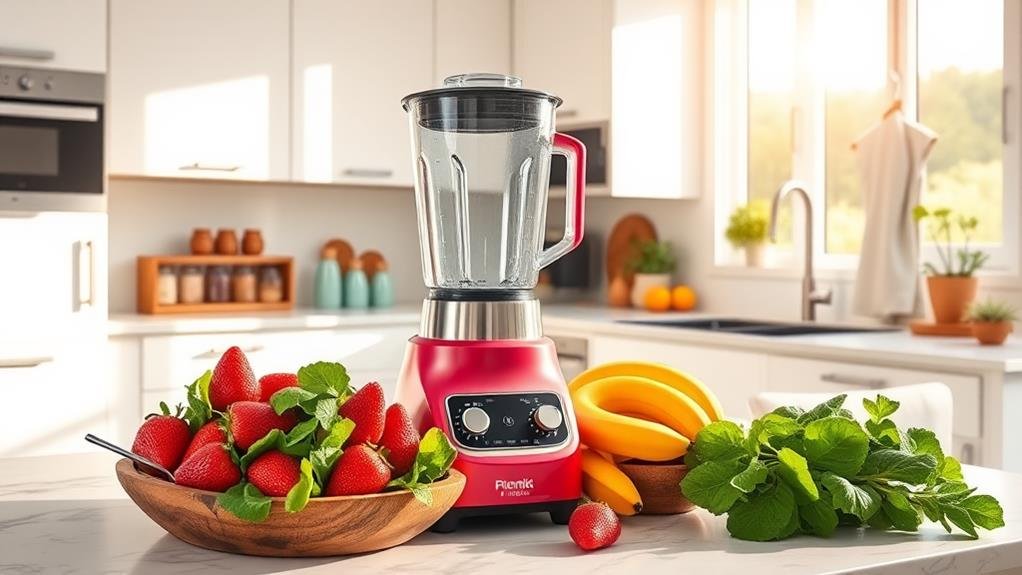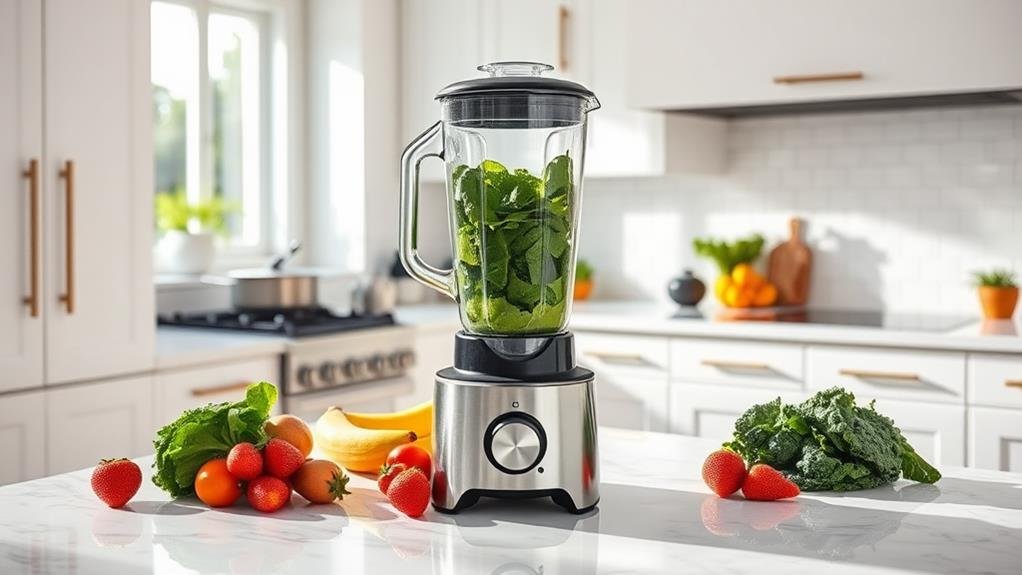Did you know that nearly 70% of blender users don't consider the motor type before making a purchase? I find this statistic intriguing, as the motor plays a vital role in the blender's performance and longevity. With various options like universal, induction, and DC motors available, it's important to match one to your specific blending needs. So, how do you determine which motor type suits your kitchen best? Let's explore some key factors that could make all the difference in your blending experience.
Understanding Blender Motors

When it comes to understanding blender motors, recognizing the different types and their functions is essential. Most blenders utilize universal motors, which are efficient and versatile. These motors are controlled by potentiometers, allowing you to adjust the speed easily. However, it's worth mentioning that while series motors can offer power, they often experience a steep speed drop-off under load, impacting their performance during tough blending tasks. High-performance blenders, which often feature these advanced motors, can handle tougher ingredients with ease and provide a smoother blending experience, making them a great investment for serious cooks in the kitchen.
Blender types and considerations also play a role in selecting the right motor for your needs.
Higher-end blenders incorporate advanced features like feedback mechanisms, including Hall sensors or pickup coils. These elements help regulate speed, ensuring a consistent blend every time. Additionally, motor controllers play a crucial role in maintaining performance by managing power delivery and enhancing blending functions. Without effective motor controllers, you might find your blender struggling, especially with tougher ingredients.
Cooling fans on the blender shafts are another significant feature. They help limit maximum speed and assist in regulating motor temperature during operation, which can prolong the lifespan of your appliance. Understanding these components is vital to choosing the right blender motor for your needs, ensuring you get the best blending experience possible.
Types of Blender Motors

Blender motors come in several types, each designed for specific blending tasks and user needs. The most common type I encounter is the universal motor, which uses potentiometers to allow for versatile motor speed control. These motors excel in handling various ingredients, providing the power necessary for different blending tasks.
Another type is the series motor, which can struggle under load, leading to a drop in speed. To combat this, higher-end models often incorporate feedback mechanisms, like Hall sensors, for better load regulation. Cheaper blenders tend to use chopping controllers, which can be less effective.
Here's a quick comparison of the main types of blender motors:
| Motor Type | Features |
|---|---|
| Universal Motor | Versatile, powerful, good for various tasks |
| Series Motor | Speed drop-off under load, needs regulation |
| Chopping Controller | Basic control, less efficient |
| Feedback Mechanism | Accurate load regulation, consistent speed |
| Cooling Fan | Helps limit speed, cools motor during use |
Choosing the right motor depends on your blending needs, as each type offers unique advantages and limitations. Understanding these differences helps [GUARANTEE] you select a blender that meets your expectations.
Motor Power and Performance

Motor Power and Performance
Understanding the types of blender motors sets the stage for exploring how motor power and performance directly influence your blending experience. When I consider a blender motor, its power becomes pivotal in determining blending performance. Higher wattage motors typically provide better results, especially when tackling tough ingredients like ice, nuts, or fibrous fruits. Blenders with strong motors, often ranging from 1000-1500 watts, are particularly effective for best blenders for crushing ice, ensuring that frozen ingredients are blended to a smooth consistency.
With a powerful motor, I've noticed that I achieve smoother consistency in my recipes, meaning I don't have to blend multiple times to get it just right. This not only saves time but also enhances the overall quality of my smoothies and soups.
Motor performance also plays a significant role in how efficiently I can complete blending tasks. A strong motor can make quick work of even the most challenging ingredients, leading to greater satisfaction in my kitchen adventures.
Understanding motor power and performance helps me select a blender that aligns with my specific blending needs. So, whether I'm whipping up a quick breakfast or preparing a gourmet dish, knowing the right motor power can make all the difference in my blending experience.
Motor Speed Regulation

Achieving the perfect mix often hinges on effective motor speed control, which I've found to be essential for consistent results. In my experience, the way a blender manages its motor speed can greatly impact blending efficiency and the overall texture of your mixtures.
For example, when making homemade nut butter, a powerful motor with precise speed control can enhance the smoothness and creaminess of the final product, allowing you to create the top blenders for nut butter. For instance, series motors might experience speed drop-off under load, leading to inconsistent results. This is where precise speed control mechanisms come into play.
When examining motor speed control, consider these key features:
- Feedback Mechanisms: Devices like Hall sensors or pickup coils help maintain peak performance.
- Load Variations: Different blending tasks often require adjustments in speed to match ingredient types and quantities.
- Cooling Fans: Cheaper blenders may use fans to regulate speed, which can impact blending efficiency.
The importance of motor speed control can't be emphasized enough. It allows you to tackle various recipes with ease, ensuring that everything from smoothies to soups reaches the desired consistency. Understanding these features will help you choose a blender that meets your blending needs proficiently and efficiently.
Choosing the Right Motor

Choosing the right motor for your blender can make all the difference in your blending experience. You'll want a motor that not only fits your blending needs but also offers consistent performance. Here's a quick comparison to help you decide:
| Motor Type | Speed Settings | Pros & Cons |
|---|---|---|
| Universal Motor | Variable (Potentiometer) | Pros: High performance, versatile. Cons: Can be noisy. |
| Series Motor | Limited (No Feedback) | Pros: Simple design, good for basic tasks. Cons: Speed drop-off under load. |
| Chopping Controller | Fixed | Pros: Affordable for casual users. Cons: Inconsistent results. |
When you're looking at a blender, consider the motor base. A strong electric motor will provide the necessary power to tackle tough ingredients. Higher-end models often have advanced feedback mechanisms, ensuring speed settings remain stable even under heavy loads. Cheaper models might skimp on this, leading to frustrating blending experiences.
In my experience, investing in a blender with a robust motor pays off in the long run. It's all about blending efficiency and getting the results you desire, so choose wisely!
Blender Motor Maintenance Tips

Maintaining your blender motor is just as important as selecting the right one. A well-cared-for motor guarantees your blender runs efficiently and lasts longer, saving you time and money. Here are a few tips I always follow for proper blender maintenance:
- Clean the motor vents regularly to prevent dust buildup and enhance cooling.
- Avoid overloading your blender with too many ingredients, as this can strain the motor and lead to overheating.
- Pay attention to unusual noises or vibrations while blending; these could indicate potential motor issues.
Frequently Asked Questions
Which Motor Is Suitable for Blender?
When choosing a motor for a blender, I'd consider brushed versus brushless options, direct drive versus belt drive setups, and whether high speed or low speed suits my blending needs best for consistent results.
Is 350W Enough for a Blender?
I've found that a 350W motor is decent for basic blending tasks, but it struggles with tougher ingredients. If you need more efficiency and performance, consider a higher wattage for better speed and blending capabilities.
What Are the Three Types of Blenders?
When I think about blenders, I see three types: countertop blenders for versatility, immersion blenders for convenience, and personal blenders for single servings. Each has unique designs, blade materials, and speed settings to fit your needs.
How to Choose a Blender Watts?
When choosing blender wattage, I consider power consumption and motor efficiency. I compare wattage to guarantee I pick one that meets my needs, especially for tougher tasks like crushing ice or blending frozen fruits.
Conclusion
To wrap up, selecting the correct blender motor can greatly improve your blending experience. Did you know that a universal motor can reach speeds of up to 20,000 RPM, making it one of the fastest options available? By grasping your blending requirements and the advantages of each motor type, you can make a well-informed decision that fits your lifestyle. Whether you're making smoothies or handling demanding tasks, there's an ideal motor waiting for you. Happy blending!

